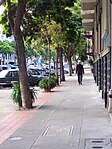Eureka Valley, San Francisco
Castro District, San FranciscoNeighborhoods in San FranciscoUse mdy dates from July 2019

Eureka Valley is a neighborhood in San Francisco, primarily a quiet residential neighborhood but boasting one of the most visited sub-neighborhoods in the city, The Castro. The neighborhood is popular with families and the LGBT community. The rainbow flag, signifying LGBT pride, can be seen displayed throughout the area. It was initially a working-class Irish neighborhood until a combination of factory jobs loss and the migration of gays into The Castro radically changed the neighborhood in the 1960s. In 1977, this district elected the first openly gay politician—Harvey Milk—to public office (San Francisco Board of Supervisors).
Excerpt from the Wikipedia article Eureka Valley, San Francisco (License: CC BY-SA 3.0, Authors, Images).Eureka Valley, San Francisco
Market Street, San Francisco
Geographical coordinates (GPS) Address Nearby Places Show on map
Geographical coordinates (GPS)
| Latitude | Longitude |
|---|---|
| N 37.76594 ° | E -122.43093 ° |
Address
Male Image
Market Street 2195
94114 San Francisco
California, United States
Open on Google Maps







